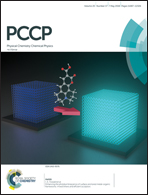Enhancing the photoluminescence of surface anchored metal–organic frameworks: mixed linkers and efficient acceptors†
Abstract
We present two approaches to enhance the photoluminescence quantum yield (PLQY) of surface-anchored metal–organic frameworks (SURMOFs). In the first approach we fabricate SURMOFs from a mix of an emissive linker with an optically-inert linker of equivalent length, diluting the emissive linker while maintaining the SURMOF structure. This approach enhances the internal PLQY. However, the increase in internal PLQY is achieved at the expense of a drastic reduction in optical absorption, thus the external PLQY remains low. To overcome this limitation, a second approach is explored wherein energy-accepting guest chromophores are infiltrated into the framework of the active linker. At the correct acceptor concentration, an internal PLQY of 52% – three times higher than the previous approach – is achieved. Additionally, the absorption remains strong leading to an external PLQY of 8%, an order of magnitude better than the previous approach. Using this strategy, we demonstrate that SURMOFs can achieve PLQYs similar to their precursor chromophores in solution. This is of relevance to SURMOFs as emitter layers in general, and we examine the optimized emitter layer as part of a photon upconversion (UC) SURMOF heterostructure. Surprisingly, the same PLQY is not observed after triplet–triplet annihilation in the UC heterostructure as after its normal photoexcitation (although the UC layers exhibit low thresholds consistent with those reported in our previous work). We discuss the potential bottlenecks in energy transport that could lead to this unexpected reduction in PLQY after excitation via triplet–triplet annihilation, and how future design of SURMOF UC multilayers could overcome these limitations.



 Please wait while we load your content...
Please wait while we load your content...